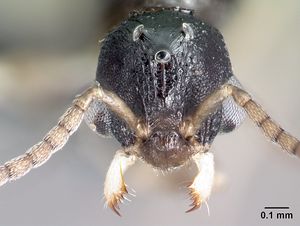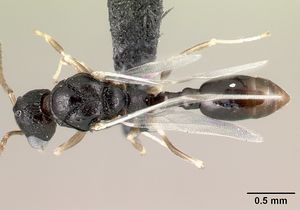Nesomyrmex rugosus
| Nesomyrmex rugosus | |
|---|---|

| |
| Scientific classification | |
| Kingdom: | Animalia |
| Phylum: | Arthropoda |
| Class: | Insecta |
| Order: | Hymenoptera |
| Family: | Formicidae |
| Subfamily: | Myrmicinae |
| Tribe: | Crematogastrini |
| Genus: | Nesomyrmex |
| Species group: | sikorae |
| Species: | N. rugosus |
| Binomial name | |
| Nesomyrmex rugosus Csösz & Fisher, 2016 | |
This species is known to occur in rainforests between elevation of 200 m and 520 m (mean: 390 m) of the eastern and southern coasts of Madagascar.
Identification
A member of the sikorai species-group.
Keys including this Species
Distribution
Latitudinal Distribution Pattern
Latitudinal Range: -15.3014° to -24.7585°.
| North Temperate |
North Subtropical |
Tropical | South Subtropical |
South Temperate |
- Source: AntMaps
Distribution based on Regional Taxon Lists
Malagasy Region: Madagascar (type locality).
Distribution based on AntMaps
Distribution based on AntWeb specimens
Check data from AntWeb
Countries Occupied
| Number of countries occupied by this species based on AntWiki Regional Taxon Lists. In general, fewer countries occupied indicates a narrower range, while more countries indicates a more widespread species. |

|
Estimated Abundance
| Relative abundance based on number of AntMaps records per species (this species within the purple bar). Fewer records (to the left) indicates a less abundant/encountered species while more records (to the right) indicates more abundant/encountered species. |

|
Biology
Castes
Worker
Images from AntWeb
   
| |
| Holotype of Nesomyrmex rugosus. Worker. Specimen code casent0374465. Photographer Michele Esposito, uploaded by California Academy of Sciences. | Owned by CAS, San Francisco, CA, USA. |
Queen
Images from AntWeb
   
| |
| Queen (alate/dealate). Specimen code casent0122544. Photographer Erin Prado, uploaded by California Academy of Sciences. | Owned by CAS, San Francisco, CA, USA. |
Male
Images from AntWeb
   
| |
| Male (alate). Specimen code casent0121890. Photographer Erin Prado, uploaded by California Academy of Sciences. | Owned by CAS, San Francisco, CA, USA. |
Nomenclature
The following information is derived from Barry Bolton's Online Catalogue of the Ants of the World.
- rugosus. Nesomyrmex rugosus Csösz & Fisher, 2016b: 22, figs. 3, 13A-C (w.q.m.) MADAGASCAR.
Unless otherwise noted the text for the remainder of this section is reported from the publication that includes the original description.
Description
Worker
Body color: yellow to brown. Body color pattern: concolorous. Absolute cephalic size: 747 μm [650, 839]. Cephalic length vs. maximum width of head capsule (CL/CWb): 1.239 [1.189, 1.277]. Postocular distance vs. cephalic length (PoOc/CL): 0.467 [0.448, 0.493]. Postocular sides of cranium contour, anterior view orientation: converging posteriorly. Postocular sides of cranium contour, anterior view shape: convex. Vertex contour line in anterior view shape: straight or feebly convex. Vertex sculpture: main sculpture rugoso-reticulate, ground sculpture smooth. Gena contour line in anterior view shape: convex. Genae contour from anterior view orientation: strongly converging. Gena sculpture: rugoso-reticulate with feeble areolate ground sculpture. Concentric carinae laterally surrounding antennal foramen: present. Eye length vs. absolute cephalic size (EL/CS): 0.226 [0.21, 0.235]. Frontal carina distance vs. absolute cephalic size (FRS/CS): 0.292 [0.277, 0.312]. Longitudinal carinae on median region of frons: present. Smooth median region on frons: absent. Antennomere count: 12. Scape length vs. absolute cephalic size (SL/CS): 0.816 [0.784, 0.856]. Median clypeal notch count: present. Median carina of clypeus: absent. Spine length vs. absolute cephalic size (SPST/CS): 0.288 [0.253, 0.352]. Minimum spine distance vs. absolute cephalic size (SPBA/CS): 0.221 [0.182, 0.256]. Apical spine distance vs. absolute cephalic size (SPTI/CS): 0.257 [0.191, 0.31]. Propodeal spine shape: straight. Apical distance of pronotal spines vs. absolute cephalic size (PSTI/CS): 0.635 [0.6, 0.692]. Metanotal depression: present. Dorsal region of mesosoma sculpture: rugose with smooth ground sculpture. Lateral region of pronotum sculpture: inconspicuously areolate ground sculpture, main sculpture rugoso-reticulate. Mesopleuron sculpture: smooth ground sculpture, superimposed by dispersed rugulae. Metapleuron sculpture: areolate ground sculpture, superimposed by dispersed rugae. Petiole width vs. absolute cephalic size (PEW/CS): 0.231 [0.2, 0.278]. Dorsal region of petiole sculpture: ground sculpture inconspicuously areolate, main sculpture rogoso-reticulate. Postpetiole width vs. absolute cephalic size (PPW/CS): 0.345 [0.308, 0.376]. Dorsal region of postpetiole sculpture: ground sculpture smooth, main sculpture dispersed rugose.
Type Material
Holotype worker: Madagascar: Prov. Antsisarana, Masoala National Park, 250 m, -15.33058 N, 50.30279 E, 13.iii.2014, collection code: BLF33157; CASENT0374465, Fisher et al. (California Academy of Sciences, CASENT0374465);
Paratypes: 2 workers, a gyne and a male with the same label data with the holotype under CASENT codes: CASENT763560, BLF33157, (1q, CAS), CASENT0374466, BLF33157, (1w, 1m, CAS); CASENT0377059, BLF32874, (1w, CAS)
Etymology
The name refers to the coarse, rugose body sculpturing.

